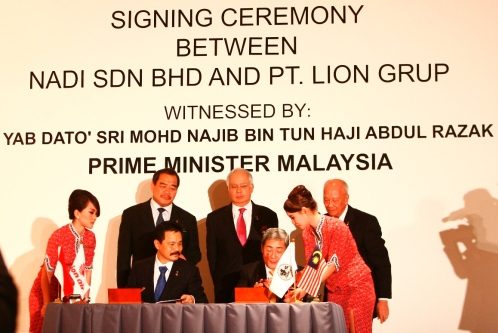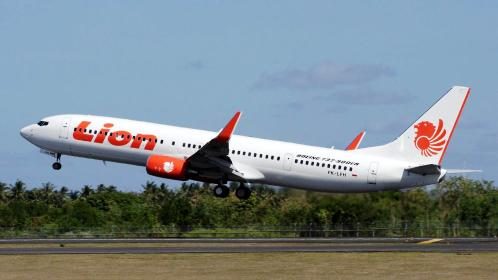Indonesian low-cost carrier Lion Air is to partner with Malaysia’s minority state-owned National Aerospace and Defence Industries (NADI) to establish a new carrier in the Asian country. The start-up, named Malindo Airways, will be 51 per cent controlled by NADI and 49 per cent by Lion Air and will operate as a hybrid airline offering low-fares but with ‘frills’ including free in-flight entertainment, a light meal and WiFi connectivity. It will also use airbridge facilities at the airports that have them, confirmed an airline source.

Malindo Airways intends to launch operations from a primary hub at Kuala Lumpur International Airport and will be based at the new KLIA2 budget terminal which is due to become operational in April 2013. The airline will initially serve a mix of domestic markets and to locations in Indonesia from May 1, 2013 before expanding to introduce new non-stop links from Kuala Lumpur to markets across Asia, including China, Thailand, Vietnam and the Philippines. According to local sources, a secondary hub is also under discussion for Kota Kinabalu while medium- and long-haul services are planned in the future.
Speaking at the formal unveiling of the new venture Malaysian Prime Minister Datuk Seri Najib Tun Razak said the collaboration not only marked another milestone in the nation's aviation industry, but also represented yet another facet of the close relationship between Malaysia and Indonesia.
"To my mind the acronym Malindo - the melodic combination of the names of Malaysia and Indonesia - has very significant historical connotations, reflecting the long intertwined history of the peoples of our two countries. In terms of this to be established airline, I believe the name reflects the bridging of the two countries by way of a wide network of flights that will connect various cities and towns regionally, opening new destinations for travellers from within the Nusantara and beyond," he said.
Malindo Airways will initially start operations with five leased Boeing 737-900ERs which will be configured in a two-class arrangement with 12 Business Class and 168 Economy seats. According to company executives it will add around 12 aircraft a year, growing to a fleet of 100 jets by the end of 2021. These additional aircraft are all likely to be transferred from Lion Air’s existing orderbook. Alongside the airline venture the co-operation between NADI and Lion Air is likely to see the Indonesian carrier send its expanding fleet of Boeing 737s to be maintained and serviced at the Maintenance, Repair and Overhaul (MRO) facilities of NADI in Malaysia.
The launch of Malindo Airways will certainly put pressure on existing operators in Malaysia. Lion Air’s president director Rusdi Kirana says the venture will offer ticket prices “lower or at a par” with the country’s leading low-cost operator AirAsia, but the carrier’s founder and chairman Tony Fernandes has played down any impact, suggesting that national entity Malaysia Airlines will face greater pressure. Lion Air is now adopting a model that has already seen AirAsia spread its reach away from its original Malaysian roots with international ventures in Indonesia, Japan, Thailand and the Philippines and will certainly change the dynamics of the Malaysian market.

Since its launch in June 2000, Lion Air has established itself as the fastest-growing operator in Indonesia. This month it has a market leading 44.7 per cent share of the country’s domestic capacity with its closest rival national carrier Garuda Indonesia holding just a 20.2 per cent share of the domestic capacity. In the international market it is currently ranked fifth largest below both Indonesian AirAsia and AirAsia. Lion Air has a 7.6 per cent share, but growth from Malindo Airways between Malaysia and Indonesia will help this share grow. Indonesian AirAsia is the country’s largest international operator with a 15.9 per cent capacity share, followed by Garuda Indonesia with 13.7 per cent of the available seats (all data from OAG Analyser; September 2012).
The table below highlights the current state of the Malaysian domestic and international markets and the strong competition that Malindo Airways will face. With the Government holding a minority shareholding with a golden voting share in NADI the barriers to its market entry will have been eased, but although its enhanced in-flight product will attract custom, it is going to be a challenge for the start-up to generate sustainable yields especially against strong competition from both AirAsia and Malaysia Airlines.
|
SCHEDULED AIR SERVICES IN MALAYSIA (non-stop departures; September 2012) |
|||||||
|
DOMESTIC |
INTERNATIONAL |
||||||
|
Rank |
Airline |
Seats |
% Share |
Rank |
Airline |
Seats |
% Share |
|
1 |
AirAsia (AK) |
1,063,080 |
51.3 % |
1 |
AirAsia (AK) |
486,180 |
25.8 % |
|
2 |
Malaysia Airlines (MH) |
630,980 |
30.4 % |
2 |
Malaysia Airlines (MH) |
473,638 |
25.1 % |
|
3 |
MASWings (MH) |
222,112 |
10.7 % |
3 |
AirAsia X (D7) |
130,819 |
6.9 % |
|
4 |
Firefly (FY) |
143,344 |
6.9 % |
4 |
Indonesian AirAsia (QZ) |
104,580 |
5.5 % |
|
5 |
Berjaya Air (J8) |
13,200 |
0.6 % |
5 |
SilkAir (MI) |
51,360 |
2.7 % |
|
(Others) |
- |
- |
(Others) |
640,176 |
33.9 % |
||
|
TOTAL |
2,072,716 |
- |
TOTAL |
1,886,753 |
- |
||
The data shows the dominant position held by AirAsia in both the domestic and international markets in Malaysia. Interestingly, three of the top four international operators in terms of seat capacity in the country are part of the AirAsia Group, with Indonesian AirAsia the largest foreign entity in this market.
It seems that alongside AirAsia and Malaysia Airlines, Malindo Airways may also have plans to compete directly with AirAsia X, the long-haul operation of the low-cost airline group. It currently flies a number of routes from Kuala Lumpur to destinations in Australia, China, Iran, Japan, Nepal, South Korea and Taiwan, markets which are already understood to be on Malindo Airways’ proposed future network map, particularly the Australian market. Speaking at the airline’s launch Rusdi Kirana suggested that the five 787 Dreamliners that Lion Air has on order that were previously earmarked for its premium start-up Batik Air, will be transferred to Malindo Airways in 2015. A new order for up to ten aircraft is currently under discussion to support Batik Air and future network growth.





